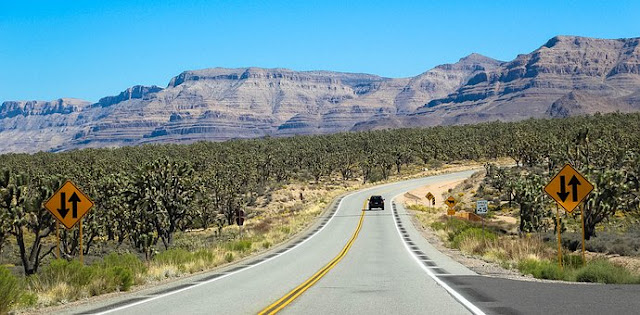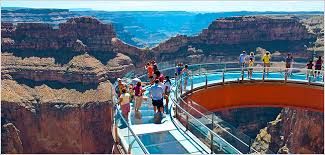Grand Canyon Description
Grand is an understatement. Glorious, exalted, divinely inspired — all are more apropos adjectives to describe the canyon. One glimpse of its majesty is all it takes to understand why the Grand Canyon is considered one of the natural wonders of the world.
The canyon is a staggering 277 miles long. At its deepest, it is about a mile from the rim to the Colorado River far below and it is as much as 18 miles wide in some spots. The park encompasses 1,904 square miles and visibility on a good day can reach up to 100 miles.
The beauty and vibrant colors of the rocks, the mighty river flowing through the center and the wide variety of plant and animal life that inhabit the canyon combine to make it a spot that 5 million people from around the world visit each year.
The Grand Canyon is something you learn about in school, see on TV and read about in books, but nothing can really prepare you for the actual sight of the giant chasm opening up in the earth before your feet.
Vicky Ricome, originally from Lima, Peru, visited the canyon recently. She said she had seen it on TV many times and had always dreamed of visiting.
"This is a dream come true. I always thought 'one day I'll go there' and this is the day. I'm so happy. It's beautiful."
- Hours of operation:South Rim - open daily, 24 hours. North Rim - open mid-May to mid-October, closed rest of the year. The Backcountry Information Center public information phone line (above) is answered only from 1 p.m. - 5 p.m., Monday - Friday.
- Cost:Entrance fees: Private vehicle, $25. Individual, $12 (good for seven days). Annual Grand Canyon Pass (individual or vehicle) $50. Annual Golden Eagle pass (all U.S. recreation sites), $80. Backcountry fees: Permit $10. Frequent Hiker (all permits annually) $25. Nightly Impact fee $5 per person.
- Payment options:Cash, Mastercard, Visa, American Express and Discover.
- Reservations:No, but air and bus tours are available.
- Location:About 300 miles southeast of Las Vegas, in Arizona.
- Age/Height/Weight restrictions:Not applicable.
The Grand Canyon has been visited and inhabited by people for centuries. Archaeologists believe that 3,000 to 4,000 years ago, the Desert Archaic people lived within the canyon. Around 1,000 B.C., the Anasazi Indians are believed to have inhabited the area. Ruins of adobe houses in the area show that Pueblo Indians also lived there, probably as early as the 1200s.
The first white men to discover the canyon were Spaniards from Francisco Vasquez de Coronado's expedition in 1540, but the canyon still wasn't widely known until 1869 when Major John Wesley Powell, a Civil War veteran, made the first recorded journey through the canyon on the Colorado River.
In 1919, the Grand Canyon received National Park status and it has been a major tourist attraction and an iconic symbol of the American Southwest ever since.
Geology 101 Grand Canyon
The massive Grand Canyon is obviously a significant geological formation, mainly because of the geologic record that is preserved there. The canyon, formed over a period of 5 to 6 million years, displays much of the early geologic history of North America.
The rocks exposed in the side of the canyon provide a striking record of the Paleozoic Era and Precambrian rocks as old as 2 billion years can also be found at the bottom.
What to do and see in Grand Canyon
The South Rim is the most visited and most accessible part of Grand Canyon National Park. There are many scenic overlooks and it is also home to the park's visitor's center, lodging, a gift shop and restaurants.
A good starting point is the Canyon View Visitor's Center located at Mather Point. The visitor's center is full of information about the canyon, including maps, weather forecasts and a bookstore. It also serves as the base for ranger-guided activities. Activities include everything from fossil walks and campfires to kid's programs and full moon walks.
Hiking the canyon or taking a scenic flight over it are the best ways to see it. Try a stop at Desert View, one of the highest points in the park. Desert View features an eight-story stone tower, which was designed by renowned architect Mary Colter to look like an Anasazi watchtower. Visitors can climb to the top and enjoy the spectacular view of the Colorado River below.
While the majority of visitors to the Grand Canyon view it from one of the scenic overlooks, the more adventurous can find many hiking trails in the canyon. There are ranger-led day hikes and walks along the Rim Trail available, as well as hikes into the depths of the canyon.
Hiking in the Grand Canyon can be very strenuous so many people opt to ride the famous Grand Canyon mules down to the bottom. A trip by mule to the bottom of the canyon takes about five and a half hours and although the ride can be challenging, those who take advantage of it will see many amazing views.
Once at the bottom of the canyon, the Colorado River makes for an excellent river rafting adventure with both exciting whitewater and smooth water rafting available. During the spring runoff, rafters may encounter 12-foot rapids. A full raft trip through the canyon can take up to 10 days, although shorter trips are available.
For those who make the trek to the bottom of the canyon, an overnight stay at the rustic Phantom Ranch is an option. The ranch, which was built in 1922, is the only lodging facility located below the rim of the canyon. Accommodations consist of cabins or dorms.
For a touch of nostalgia, climb aboard the Grand Canyon Railway -- a vintage train that runs from Williams, Ariz. to Grand Canyon National Park. The Grand Canyon Railway made its first journey to the Grand Canyon in 1901 and the same rail line is used today.
Visitors can also venture to the Grand Canyon West, which is managed by the Hualapai Tribe. The newest attraction at the Grand Canyon West is the breathtaking Skywalk (pictured here), which opened in March 2007 after three years of construction. The Skywalk is a glass bridge suspended 4,000 feet above the Colorado River, allowing visitors to actually walk out over the canyon and experience views unlike any other.
For those who are a little nervous, it helps to remember the Skywalk can hold 71 million pounds and can withstand winds in excess of 100 miles per hour.
The Grand Canyon West is also home to Hualapai Ranch, where you can saddle up for a horseback ride and see cowboy demonstrations.
Tours
Tackling the Grand Canyon on your own can be daunting and if you don't want to make the drive yourself, there are a variety of convenient tours available from Las Vegas. You can explore the canyon on guided tours by helicopter, bus, river raft, SUV or airplane. If you have a day to spend, a bus tour can be economical -- just make sure you plan on a 12 to13-hour trip. If time is of the essence, you can take a quick flight over the canyon and still see the magnificent sights.
Helpful hints
While the Grand Canyon is an exciting place to visit, there are a few things to keep in mind that will help make your trip a much smoother one.
Lodging is available at Grand Canyon Lodge in the park. Lodging is also available outside the park at Tusayan, 7 miles/11 km south of Grand Canyon Village. Lodging at and around the canyon is booked well in advance, especially during the summer. Be sure to make reservations as far ahead as possible. Mule trips can be booked 13 months in advance and they fill up early.
There are restaurants, snack bars and markets in the park.
Summer temperatures on the South Rim are fairly moderate, however, visitors need to remember that temperatures at the bottom of the canyon can top 100 degrees. Bring sunscreen, a hat, water, warm clothing for the evening and sturdy walking shoes.
And while most tourists visit in the warmer months, the snow-covered landscape in the winter is just as beautiful -- the South Rim of the canyon is open 365 days a year.
Most importantly, visitors should take care not to disturb any of the rocks, wildlife or plant life in the canyon and be sure to pick up after themselves. As former President Teddy Roosevelt once said of the Grand Canyon, "Leave it as it is. The ages have been at work on it, and man can only mar it. What you can do is to keep it for your children, your children's children, and for all who come after you, as one of the great sights which every American, if he can travel at all, should see."











0 Comments